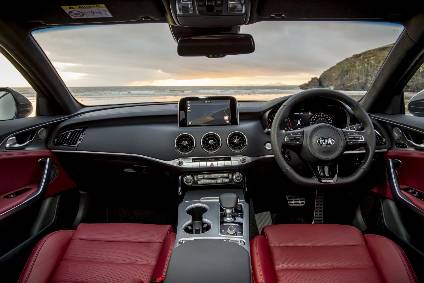
Inspired by the gran turismos of the 1970s, Kia's first GT and rear-wheel drive car arrived in showrooms across Britain last month. The Stinger is also the fastest car the Korean automaker has ever put together. Continuing QUBE/just-auto's review of interior design and technology trends, we slip inside a GT S trimmed model to take a closer look.
The slinky five-door gran turismo traces its roots back to the Kia GT concept unveiled at the 2011 IAA in Frankfurt. So why has it taken Kia six years to turn the concept into a production car? Kia gives three reasons. "The first is that we wanted to enhance our brand's positioning so that a model like Stinger would be sustainable within our line-up. The Kia of 2018 is very different to the Kia of 2011, when the GT Concept was revealed. Kia is now a design-led challenger brand, not one known purely for mass-market transport rooted in value. Then we had to find somewhere to build it. That became possible when we introduced the K9/K900 luxury saloon (not sold in the UK), which is also rear-wheel drive. Stinger goes down the same production line. And finally, we were determined to undertake arguably the most rigorous testing regime for any car in our history to ensure that Stinger would be an authentic gran turismo."
The net result certainly makes a powerful statement about the brand. There are five versions of this classy-looking brand-builder, based on three trim grades, (namely GT-Line, GT-Line S and GT S) and three turbocharged engines all with an eight-speed automatic gearbox.
The Stinger moves Kia into uncharted territory.
The arrival of the Stinger means Kia can compete head on in Europe with the likes of BMW and Audi. Although it moves Kia into uncharted territory, it will be interesting to see the impact of the Hyundai Motor Group's rear-drive platforms from the Genesis brand on future models. The Hyundai Genesis rear-wheel-drive luxury sedan has been manufactured and marketed by Hyundai since 2008 and is now in its second generation.
Cocooned in a cockpit
Once seated in the eight-way power adjustable leather heated and cooled driver seat, the eye is drawn to the horizontal sweep of the high-mounted, wing-shaped leather-clad dash which is divided by a tablet-style eight-inch touchscreen for the Europe-wide sat-nav and infotainment system.
How well do you really know your competitors?
Access the most comprehensive Company Profiles on the market, powered by GlobalData. Save hours of research. Gain competitive edge.

Thank you!
Your download email will arrive shortly
Not ready to buy yet? Download a free sample
We are confident about the unique quality of our Company Profiles. However, we want you to make the most beneficial decision for your business, so we offer a free sample that you can download by submitting the below form
By GlobalDataAlso prominent on the dash centre stage are three aeronautically inspired spoked circular air vents that give a reassuring click when turned off and on.
The rest of the cabin is cloaked in leather, from the door armrests and D-shaped heated steering wheel to the gearshifter. Touches of aluminium glint all around, adding to the luxurious feel of the cabin.
Dual automatic air-con is standard across the range. Another joy while driving is the head-up display showing speed, navigation instructions and audio, cruise control and blind spot detection information. The GT S also has a 360-degree around-view monitor.
Beneath the touchscreen is a chrome panel housing a line of buttons flanked by two dials to control the audio. Further down is the HVAC panel and beneath that is a USB port and handy wireless phone charger.
There is surprisingly enough room in the front and back of the Stinger to feel comfortable. To rattle off some measurements, there is 974mm of headroom in the front and a touch less – at 939mm – in the rear. The respective figures for legroom are 1,083mm and 925mm, and for shoulder room, 1,433mm and 1,391mm. The boot capacity of this hatchback with the 60:40 split rear seats upright is generous, liberating 406 litres of luggage space, extending to 1,114 litres with the seats folded.
All about that bass
The GT S has an absolute knockout 15-speaker Harman Kardon surround sound system.
In the audio department, the GT S has an absolute knockout 15-speaker Harman Kardon surround sound system with subwoofer, external amp and front centre speaker. It also features something Harman calls Clari-Fi, which restores the sound sometimes lost when digital music files are heavily compressed, and QuantumLogic Surround Sound, which redistributes signals from the original recording to deliver multi-dimensional playback.
Harman owns a number of well-known brands, including headphone maker JBL. Yet since Harman was acquired by Samsung for US$8bn last year, it has evolved into an even bigger audio powerhouse. During the most recent CES (Consumer Electronics Show), Harman took over the Hard Rock Hotel and filled its conference rooms with the very latest in-car audio equipment. While there, we spoke to Bill Wyman, Harman's VP of global marketing for Car Audio about the Stinger and brand fit. He told just-auto: "One of the key things that we always work on is brand fit, and that brand fit carries over into some of the product attributes in terms of the vehicle as well. So that brand fit is really about what is the goal of the expression and the experience that the OEM has, and how do we marry that up with our brand, our technology and our products to ensure that we're delivering on exactly what's important to them? If they're looking for a high-performance story, we're going to bring the high-performance capabilities into the audio system as well. It's really a collaborative approach that we do."
Hitting the right note
Stinger is also the first Kia with an Active Sound system to enhance the engine note via the car's audio rather than through an actuator which channels noise into the cabin. This system was engineered in Europe and is consistent with the type of engine. The net result is that 3.3-litre engine authentically enhances the distinctive V6 engine note. Sound engineers paired the system with the multiple driving modes selector, enabling drivers to change the level of engine noise in the cabin. The sound does indeed become slightly louder and more aggressive in tone as you switch modes.
Advanced driver assistance systems
As we would expect of a car that comes with a forty grand price tag, the GT S boasts loads of ADAS equipment. Although it can't drive itself … yet. The spec sheet left in the car listed Autonomous Emergency Braking, Blind Spot Detection with Rear-Cross Traffic Alert and High Beam Assist. It also has Electronic Stability Control linked to Vehicle Stability Management (VSM) to correct potential skids without any intervention from the driver. VSM incorporates a new dynamic torque vectoring system which monitors driver inputs and road conditions and automatically applies power and braking force to the inner rear wheel to minimise understeer and enhance tractability and steering feel.
On the road
The 3.3-litre turbo V6 Stinger is not cheap to run so not for the stingy.
Driving the 3.3-litre twin-turbo V6 T-GDi certainly sets pulses racing, accelerating from 0 to 60mph in a heartbeat with shockingly good Brembo braking performance. Our road test on 19-inch wheels along a mixture of winding country roads, crawling town traffic and motorways felt poised and engaged, and returned a combined real-world mpg of, well, let's not go there. The Stinger GT S is not cheap to run so not for the stingy.
Kia points out that the Stinger is not a sports car created to be fast at the expense of comfort. "The Stinger has nothing to do with being the first to arrive," says Gregory Guillaume, Kia's Chief Designer. "This car is all about the journey. It's about passion. To embody that passion we believe that proportion is everything. From the wheelbase to the greenhouse, the width and the height – even the shape of individual body panels – getting the perfect balance is critical." Size-wise, Stinger is 4,830mm long, 1,870mm wide and just 1,400mm tall, and has a 2,905mm wheelbase.
A dial on the centre console positioned just behind the gearshifter allows you to adjust the shocks and driving mode, choosing from either Eco, Comfort, Smart, Sport and Sport+. Prior to its release, Kia put right-hand drive versions of its Stinger through a further level of dynamic testing in the UK to optimise steering and suspension components.
Kia expects to sell around 1,800 in the UK this year, with GT-Line S the most popular trim level. Retail sales will account for around 60 percent of the total. Stinger is built at Kia's Sohari factory in South Korea, on a production line dedicated to rear-wheel-drive cars. The same line also builds the Kia K9 (K900 in America and Quoris in some Middle East and South America markets).
On balance, what is not to like? The Stinger has the interior feel and quality we have come to expect from Kia. The fit and finish of the plush leather interior – together with lots of equipment to hand – make it a pleasure to drive.





